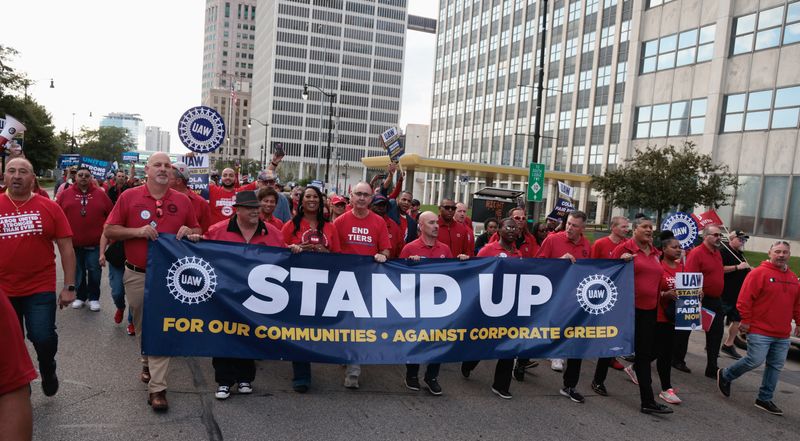By Dan Burns
(Reuters) -U.S. union membership rates fell to fresh record lows in 2023 despite it being a year of headline-grabbing organized labor strikes from the Rustbelt to Hollywood and some continued organizing successes at companies such as Starbucks (NASDAQ:SBUX).
The union membership rate fell to 10.0% from what had already been a record-low 10.1% in 2022, the Labor Department said on Tuesday in an annual census of the U.S. organized labor landscape that also showed continued growth in union membership among people of color and a narrowing pay advantage for union workers.
The number of union members, meanwhile, ticked higher for a second year, to 14.4 million, but the fact that overall employment among wage and salary workers rose faster resulted in a further decline in the membership rate.
"Although union density remained flat in 2023, that doesn’t reflect the surging momentum that working people have carried into this year," AFL-CIO President Liz Shuler said in a statement. "Waves of workers across industries and geography are joining unions despite vicious union-busting campaigns by large corporations."
The increase in union members was entirely the result of the continued climb in organized labor participation by non-whites. Black union membership increased by 122,000 to the highest in two decades while Latino membership rose by 127,000 to the highest since the Bureau of Labor Statistics began tracking it in 2000. White and Asian union membership fell.
The membership rate among private-sector workers was unchanged at a record-low 6%.
“Workers want unions, but a broken system is undermining their efforts to organize at every turn,” said Heidi Shierholz, president of the Economic Policy Institute. “Employers have exploited weaknesses in U.S. labor law, and federal and state policymakers have failed to prevent this from happening.”
SMALLER PAY PREMIUM
The rate for government workers, which is more than five times the private-sector rate, slid to 32.5%, the lowest on record, from 33.1% in 2022. The government sector saw a net decline of 52,000 union workers in 2023, with declines in union membership at the state and local government level outweighing a 60,000 rise in federal government union member ranks, the largest since the BLS started tracking it in 2000.
The data also showed that union members' wage superiority continued to erode.
On the eve of the Global Financial Crisis in 2007, a union member's weekly pay on average was more than 30% higher than a non-union worker's earnings. By last year that margin was down to below 16%, perhaps owing to a tight labor market that has rewarded job switchers with outsized pay gains while union wage increases are set through multi-year negotiated contracts.
Since 2019, a run that has seen the highest inflation since the 1980s, union wages on average have climbed 15.3% but non-union weekly pay is up by 22.2%.
EPI's Shierholz said the smaller premium may also owe something to "spillover effects" when wider pay standards set by unions help boost non-union pay. It's a phenomenon she said played out "in real time" recently in the pay increases for non-unionized autoworkers after strikes by the United Auto Workers at Ford (NYSE:F), General Motors (NYSE:GM) and Stellantis (NYSE:STLA) resulted in substantial union pay hikes.
"So the union premium is reduced by the spillover effect, but that's all good as far as workers are concerned," Shierholz said.
SMALLER FOOTPRINT, BUT STILL WITH CLOUT
Union membership has been in steady decline since the 1970s and is now less than a third of its peak rate in the 1950s when more than 30% of workers were in a union.
That said, unions carry outsized political clout, especially in states critical to the outcome of this year's presidential race like Michigan and Pennsylvania where membership rates are higher than the national average. In Michigan, 12.8% of workers were in a union, down from 14% a year earlier, the report showed, while in Pennsylvania union membership rates bucked the trend to climb to 12.9% from 12.7%.
When the UAW went on strike last year against Detroit's "Big 3" automakers, President Joe Biden joined the picket line in Michigan, and he has repeatedly backed the union's efforts to organize at Tesla (NASDAQ:TSLA) and Toyota (NYSE:TM) among others.
That has yet to win him the UAW's endorsement, however, in a November election that appears on course to feature a repeat run-off between Biden, the likely Democrat nominee, and former President Donald Trump, the frontrunner for the Republican nomination.
Last year was the most active for organized labor walkouts in more than two decades, with 36 strikes that idled at least 1,000 workers at a time, the most since 2000, according to BLS data. In addition to the UAW strikes, Hollywood actors, screenwriters and directors all staged work stoppages of varying durations and thousands of hotel workers walked off the job in Los Angeles in a series of rolling strikes targeting individual properties.
